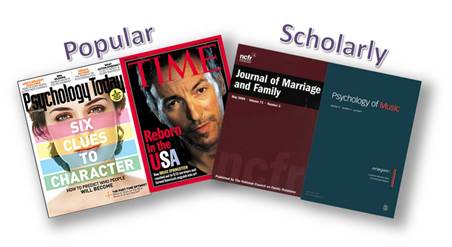Chapter 25: Finding and Evaluating Research Sources
Learning Objectives
By the end of this chapter, you should be able to:
- Distinguish between popular sources and scholarly sources
- Identify different types of sources that can be used for technical projects
- Evaluate research sources with a critical lens by considering their authority, content, and purpose
Key Terms and Concepts
- scholarly sources
- popular sources
- authority, content, and purpose
Finding and Evaluating Research Sources
While going through Bitzer and Aristotle’s rhetorical theory, you will need to start looking up some sources you can use for your report. Perhaps you already know of some sources that you could pull from. But, if you don’t have any sources in mind, or if you don’t know how to even start looking for them, that’s okay too. We’ll talk more about strategies for conducting research in the next chapter. Right now, we want to make sure you know how to properly evaluate the sources you do find when you start your research.
Popular vs Scholarly Sources
In this “information age,” when so much information is available at our fingertips on the Internet, it is crucial to be able to critically search through the reams of information in order to select credible sources that can provide reliable data to support your ideas and convince your audience. In the era of “fake news,” deliberate misinformation, and “alternative facts,” developing the skill to evaluate the credibility of sources is critical.
Sources can be broken up into two categories: popular and scholarly. How would you define the difference between the two? Can you come up with some examples of both? Ideally, when you think of both categories, you should think of items such as those in the figure below.

Figure #1 Examples of Popular vs Scholarly Sources.[1]
Why are scholarly sources more desirable than popular sources? Is it ever a good idea to use one source type over the other in the report writing process? Let’s look at this a little more deeply.
Watch the video below to help distinguish between the two:
Link to Original Video: tinyurl.com/poporscholarysources
Scholarly articles published in academic journals are usually required sources in professional communication; they are also an especially integral part of engineering projects and technical reports. Since you are researching in a professional field and preparing for the workplace, there are many credible kinds of sources you will draw on in a professional context. How many can you list? Table #1 below lists several types of sources you may find useful in researching your projects.
Table #1: Typical Research Sources for Technical Projects
Critically Evaluating Sources
Clearly, there are a lot of places where you can pull sources from. However—and this is a big however—it is essential that you critically evaluate your sources for authority, content, and purpose.
Anyone can put anything on the internet, and people with strong web and document design skills can make this information look very professional and credible, even if it isn’t. Since a majority of research is currently done online, and many sources are available electronically, developing your critical evaluation skills is crucial to finding valid, credible evidence to support and develop your ideas. In fact, this has become such a challenging issue that there are sites like List of Predatory Journals that regularly update its online list of journals that subvert the peer review process and simply publish for profit.
When evaluating research sources and presenting your own research, be careful to critically evaluate the authority, content, and purpose of the material, using the questions in Table #2.
Table #2: Evaluating the Authority, Content and Purpose of the Information
Going through all those questions may seem like a tedious, unnecessary process, but it is essential that you consider these questions as you acquire sources for your reports. Not doing so can negatively impact your credibility as a professional.
Consider it this way: let’s say you are presenting a report to a potential client. If they find out you used sources that lack authority, are not relevant or recent, or do not really serve their purpose, how will they view you? How will that affect their view of the company you work for?
Ultimately, critical thinking lies at the heart of evaluating sources. You want to be rigorous in your selection of evidence, because once you use it in your paper, it will either bolster your own credibility or undermine it.
Key Takeaways
- Not all sources are created equal when it comes to research. There are two main categories: popular sources and scholarly sources. Of the two, scholarly sources are more credible because they have to go through a peer-review process in order to be published.
- However, you still want to make sure you evaluate the sources your find for authority, content, and purpose regardless of where you found it.
References
Government of Canada, Statistics Canada [online]. Available: http://www.statcan.gc.ca/eng/start ↵
Kurland, D. (2000). What is critical thinking? How the language really works: The fundamentals of critical reading and effective writing. https://www.criticalreading.com/critical_thinking.htm
List of predatory journals. (n.d.). Stop Predatory Journals. https://predatoryjournals.com/journals/
Attributions
This chapter is adapted from Technical Writing Essentials (on BCcampus) by Suzan Last, and is used under a Creative Commons Attribution 4.0 International License.
Cover images from journals are used to illustrate difference between popular and scholarly journals, and are for noncommercial, educational use only. ↵
sources that are typically peer-reviewed by experts, more technical in nature, and cite references
sources that are good for background information and ideas, but not for including in actual research
a quality that allows others to trust and believe you
an account of your investigation into a subject, presented in a written document or oral presentation that has conventional formatting

